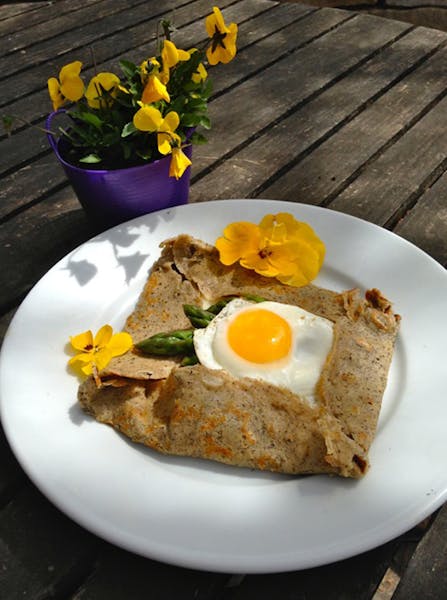"Let's get this straight, a crêpe is not a galette, Madame," the man behind the big skillet told me. He winked kindly at this silly American, folded the delicate buckwheat pancake into a triangle and slipped it into a waxed paper sleeve.
As I wandered the bustling market in the French city of Treguier, in the Breton region, I savored each bite, its melted tangy local butter trickling down my arm.
Galettes, the original crêpes, were born in Brittany, and are always made with the buckwheat that thrives on the desolate and rocky Breton moors. In the north, you'll find them made solely of this flour and water; to the south, the batter includes eggs, milk and melted butter. They are always served with a savory filling, never, ever sweet (mon dieu!). The favorite rendition is "galette complete" topped with cooked spinach, poached egg and nutty Gruyère cheese. But you'll also find them filled with scallops, mushrooms and chicken.
Last summer, I ate them topped with tossed greens or shrimp salad or tomatoes, olives and salty sheep cheese. And I ate them "simple," with the Breton butter, either warmed or at room temperature. In fact, I ate them whenever I pleased.
Crêpes, on the other hand, are fashioned from white flour that appeared at the turn of the 20th century. Until then, pure white flour was as expensive as sugar, honey or meat. These thin pancakes are softer than buckwheat galettes and may be served filled either with savories or sweets. On the streets of Paris, you can choose a snack of crêpes with fresh strawberry jam or Nutella or lemon crème. Find them in bistros rolled around asparagus and wild mushrooms or a fluffy omelet of eggs, herbs and chèvre.
Crêpes and galettes translate easily into our kitchens. The ingredients are simple: You just need a flat, heavy pan. Just like pancakes, the first couple of crêpes you make might not be perfect, so be patient until you get the knack.
In trying to interpret the French recipe for galettes, I realized the need to mix a little white flour in with our buckwheat to reach the right consistency. Compared with the French, our local buckwheat flour is darker and a bit heavier, so adding a little white flour lightens and brightens it up.
As long as you're making crêpes, it's sensible to flip up a big batch to freeze and enjoy later. Throughout France, grocery stores carry crêpes and galettes, packaged and ready to reheat. When layered between sheets of parchment paper and stored in plastic bags, these will keep several days in the refrigerator and freeze beautifully. They're great to have on hand.
Crêpes and galettes themselves are made with simple, convenient ingredients. The fun begins with the filling. Here are the basic recipes for both kinds. Know that the savory fillings work well with both the crêpes and galettes. But remember, with galettes, the filling is never, ever sweet.
Beth Dooley is a Minneapolis author and cooking instructor.

Gophers football coach P.J. Fleck lists 'resort-style' Edina home for $3.9 million
Mexican film wins top prize at Moscow International Film Festival while major studios boycott Russia
Why you might have heard Paul Simon's 'The Sound of Silence' at Spanish Mass

Minneapolis native Poppy Harlow parts ways with CNN

